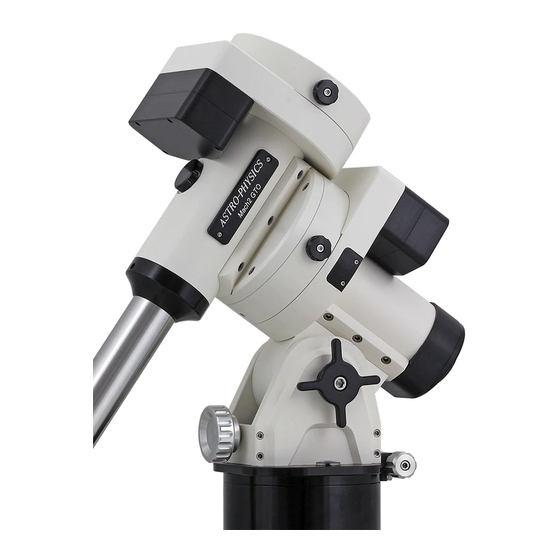ASTRO-PHYSICS 900 German Equatorial Руководство - Страница 10
Просмотреть онлайн или скачать pdf Руководство для Аксессуары ASTRO-PHYSICS 900 German Equatorial. ASTRO-PHYSICS 900 German Equatorial 12 страниц. Polar alignment telescope and illuminator (pasill)
Также для ASTRO-PHYSICS 900 German Equatorial: Краткое руководство по эксплуатации (2 страниц), Руководство (3 страниц)

PUSH BUTTONS: The four red buttons are arranged so that the left and right buttons control the movement in right
ascension, and the top and bottom buttons control the declination. This is the normal orientation of objects in
the eyepiece field. If the star moves down when you push the "N" button, move the DEC REV (Dec. Reverse)
switch into the opposite position. Pushing the right hand button "E" should cause the star to move to the right.
If it moves to the left, move the R.A. REV (R.A. Reverse) switch to the other position. When properly set up,
the controller buttons will cause the object to move according to your orientation at the eyepiece.
DRIVE RATES: The control box has three drive rates to choose from, SID (sidereal), SOL (Solar), and LUN (lunar).
Select the position appropriate for the object under observation.
King Sidereal:
Solar:
Lunar:
SLEW RATES: There are two slew (rates): 8x and 16x slew rate. The slew
rates are for positioning objects in the field. Use the guide rates for
fine guiding at high powers during astrophotography. Move the
switch to select the mode that you prefer.
GUIDE RATES: If you wish to engage the fine guiding rates of 1x, 0.5x, and
.25x, move the first switch to GUIDE and the second switch to the
1x, .5x, or .25x position.
DECLINATION BACKLASH CONTROL: When using the 1x, .5x, and .25x guide
rates in declination, you may find that there is a delay when
attempting to reverse the motion of the star. Normally declination
drift is only in one direction, and will require correction with only one
button. However, occasionally it may be necessary to reverse the
motion. The multiple gear train inside the drive motors takes a
considerable number of pulses to unwind and rewind in the opposite
direction. To compensate for this, we have included a circuit that
pulses the motor very rapidly for a moment before continuing at the
slower rate. Because the amount of delay varies with each motor,
we have installed an 8 - position switch which can be used to dial in
the exact amount of compensation. Starting from the left, engage
one switch at a time into the up position until the delay at .25x guide
rate is minimum. If too many switches are engaged, the star will
over shoot the desired position.
PERIODIC ERROR MEMORY: The drive controller contains a very
sophisticated periodic error compensation circuit. Because the
majority of the periodic error is due to the worm and is quite
predictable, it is possible to significantly reduce it by simply having
the controller "memorize" your button inputs and automatically plays
them back for each cycle of the worm. This circuit has some unique
features that makes it easy to operate and almost totally foolproof.
To start the process of recording the periodic error, align your
telescope accurately on the pole so that you get minimum R.A. and
Dec. drift. Place a medium brightness star on the crosshair at
moderately high power so you can easily see the R.A. gear drift. Be
sure that the night is steady enough with minimum atmospheric
motion, and pick a star near the zenith to minimize atmospheric
refraction errors. The recording process will take about 6.5 minutes
to complete.
When you are ready to begin, be sure that the star is on the
crosshair, and slide the play/record switch into the "record" mode.
The green LED will come on for the 6-minute period, and will
Tracking rate for observing planets, stars,
galaxies, and other distant objects.
Tracking rate for observing the sun.
Tracking rate for observing the moon.
- 10 -
